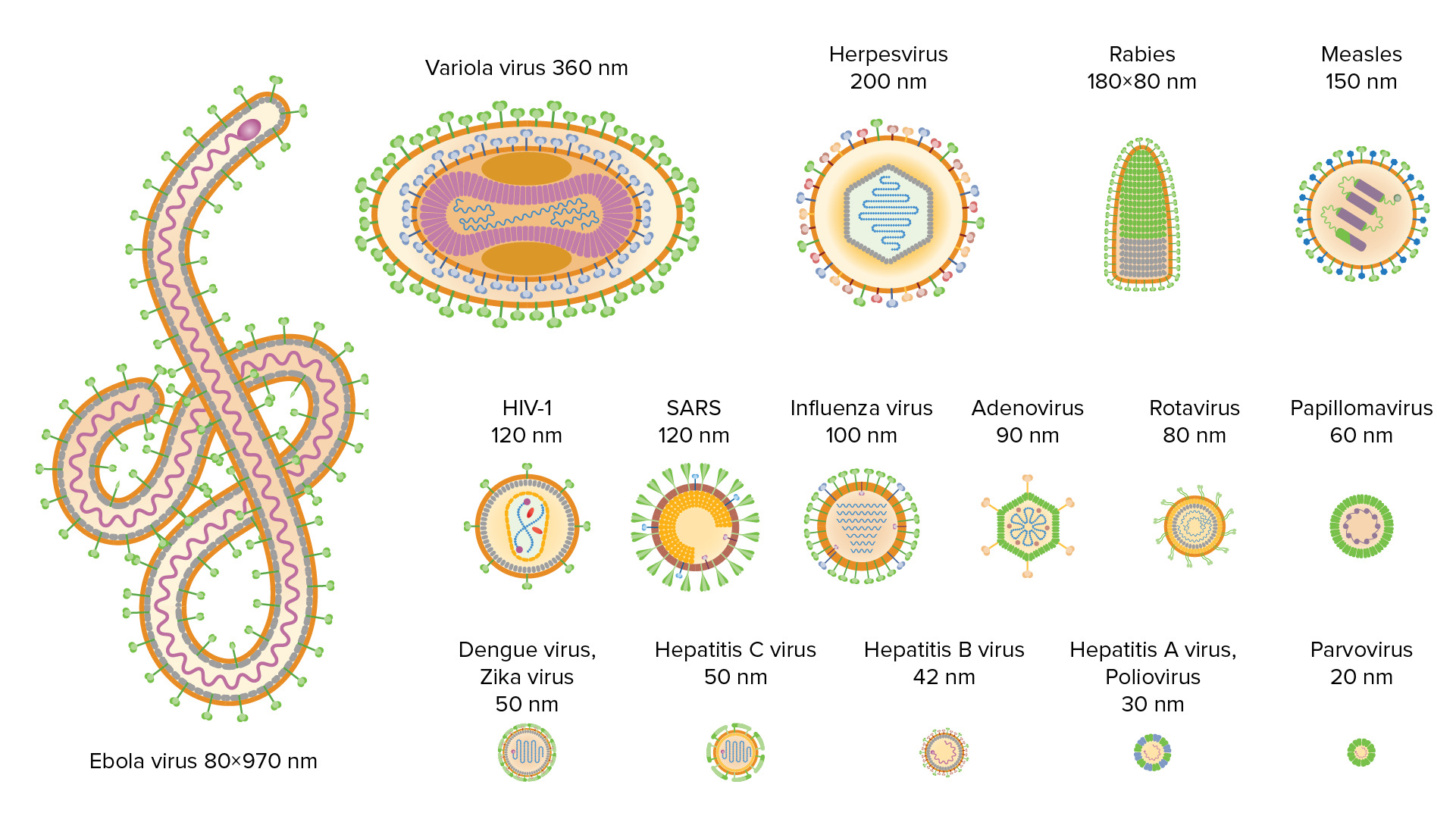Playlist
Show Playlist
Hide Playlist
Viruses are Very Small – Viruses
-
Slides 03 Viruses MicrobiologyBasic V3.pdf
-
Download Lecture Overview
00:00 Another key part of the definition of a virus is that they're small. 00:06 And years ago it use to be very small but we've change this as we discover new viruses because we're finding bigger and bigger viruses. 00:14 So, let's illustrate that by this slide. 00:17 Here we have a part of an E.coli bacteria which a rod-like bacteria that are part of your intestinal tract. 00:24 It's magnified about a 100,000 times. 00:26 You can see some flagella on this slide. 00:29 And attached to the bacterium is a bacteriophage or a virus that infects the bacterium. 00:35 You can see it's quite small compare to the bacterium itself. 00:38 Now, above the bacterium that first green line is a virus particle. 00:44 It's called tobacco mosaic virus. It's a virus of plants. 00:47 It's the first virus that was discovered. 00:50 And above that to the left its an HIV-1 virus particle. 00:54 So you can see in relation to the bacteria they're quite small although they are visible at this magnification. 01:00 Now, in the little box there are other viruses as well as cellular components that I'd like to compare. 01:07 So you get an idea of how big things are, but they're too small to see in this magnification. 01:12 So, let's move up to a million fold magnification and now we can see them. 01:17 At the bottom on the left is a poliovirus particle, and above it is a ribosomes. 01:23 So, a ribosome is cellular component that's used to make protein. 01:26 So, you can see polio is about the size of a ribosome. 01:29 And all the way above it the component mark A that is a carbon atom. 01:37 So, you can see viruses are on the atomic level. 01:41 Some of them are not much bigger than individual atoms. 01:44 Now, to the right of this slide are various cellular components. 01:47 They're acting in miles and fibrous in a variety of enzymes of different sorts. 01:52 So, viruses exists at the molecular level but they also get much bigger as well. 01:58 Here's another way of looking at the relationship between virus size and cell size. 02:05 Here is a cell surrounded by four virus particles. 02:08 These happen to be herpesviruses. 02:10 And let's expand this and look at just the part of the membrane of the cell. 02:14 You can see the plasma membrane and then beneath it are a variety of cellular components like ribosomes. 02:19 And there's the herpesvirus particle which is 200 nanometer in diameter. 02:24 Where you can also see now at this magnification there's some polioviruses which happen to be about 10 times smaller than the herpesvirus. 02:32 So, we couldn't see them in the original picture. 02:35 So, viruses are much smaller in most cases than cells. 02:38 Maybe some of you are wondering how many viruses would fit on the head of a pin. 02:45 So, let's answer that question. 02:47 Here is a pin head and in the very center you can see something that's very tiny and red. 02:53 So, let's expand that. That happens to be a red blood cell. 02:57 Now, what we could not see in the original pin but we can see now. 03:01 There's something green to the left of the red blood cell. 03:03 What is that? Those are E.coli cells. 03:07 And now, at this magnification we can see there's something below the E.coli. 03:12 Then if we magnify that even more we can see that's Ebolavirus. 03:16 And below the Ebolavirus now is a Rhinovirus. 03:20 So, the only thing we can see on the pin in the very first magnification is the red blood cell, but you can see that viruses are much smaller. 03:28 So, the answer is about 500 million Rhinoviruses will fit on the head of a single pin. 03:35 That's a lot of viruses and when you sneeze you're exhaling droplets of viruses. 03:42 If you happen to have a common cold. 03:43 So, if you're infected with a Rhinovirus every time you sneeze you're firing aerosol that contains thousands and thousands of viruses. 03:51 And this of course is part of the viral strategy for finding new host. 03:56 They make lots of progeny, most of them don't go anywhere but you just need one to find a new host and start a new infection.
About the Lecture
The lecture Viruses are Very Small – Viruses by Vincent Racaniello, PhD is from the course Microbiology: Introduction.
Included Quiz Questions
Which of the following is the smallest organism?
- Poliovirus
- E. coli
- Tobacco mosaic virus
- HIV-1
- Bacteriophage virus
Which of the following is approximately the same size as the poliovirus?
- Ribosomes
- Carbon atom
- Actin
- Myosin
- HIV-1
What is the diameter of a herpesvirus?
- 200 nm
- 109 nm
- 400 nm
- 300 nm
- 900 nm
Customer reviews
5,0 of 5 stars
| 5 Stars |
|
5 |
| 4 Stars |
|
0 |
| 3 Stars |
|
0 |
| 2 Stars |
|
0 |
| 1 Star |
|
0 |




